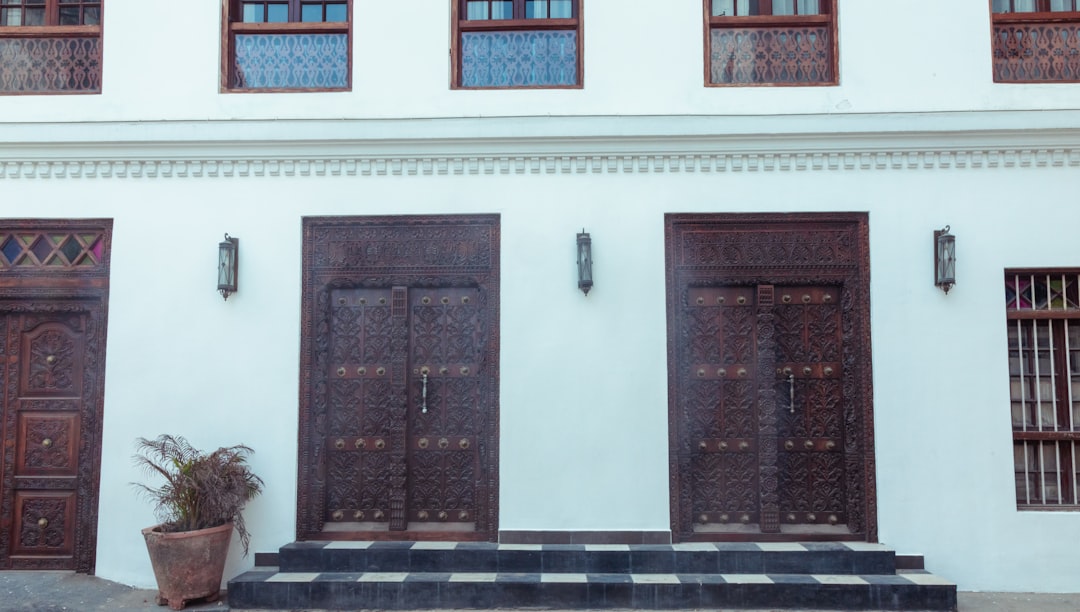

Engage prospects with a scan and streamline customer engagement with FREE QR code marketing tools by Sona – no strings attached!
Create a Free QR CodeFree consultation

No commitment

Engage prospects with a scan and streamline customer engagement with FREE QR code marketing tools by Sona – no strings attached!
Create a Free QR CodeFree consultation

No commitment
Home management services face challenges unique to both single-family and multi-residence properties: gaps in communication, manual processes that delay action, and missed opportunities to engage residents or owners at critical moments. In an environment where tenants expect near-instant responses and service providers juggle multiple locations, the risks of missed maintenance requests, untracked interest, and general inefficiency can result in lost revenue and dissatisfied residents. Without capturing real-time engagement or making it easy for people to take action, even the best-managed properties can struggle to scale or personalize their service.
Increasingly, QR codes are being leveraged as an approachable way to bridge offline and digital interactions, allowing residents, prospects, and vendors to move seamlessly between physical spaces and digital workflows. By making it simple to book a tour, request a repair, or access important information without downloading an app or waiting for someone to answer the phone, QR codes provide a frictionless channel that meets modern expectations for speed, accessibility, and responsiveness.
This article demonstrates how property management teams can strategically deploy QR codes at key touchpoints, helping reduce admin overhead, ensure no high-intent visitor is missed, and gather actionable insights. From property tours and onboarding sequences to feature-specific engagement and service requests, you will see how digital-first approaches offer a practical response to the most persistent pain points in home management, unlocking new data streams for improved targeting, retention, and resident satisfaction.

Traditional paper forms and phone intake often suffer from incomplete data, delayed processing, and lost opportunities, especially when prospects engage after office hours or abandon forms before submitting. QR codes deliver a solution by guiding users to digital workflows that track every interaction, even if the process is not completed.
Replacing analog steps with QR-enabled flows transforms the resident and prospect experience. Tour sign-up sheets become instant booking links, fridge magnets become smart maintenance portals, and yard signs convert drive-by interest into trackable leads. With a platform like Sona QR, every scan is time stamped and attributed to a campaign or location, which means fewer missed follow-ups and more qualified interactions flowing into your CRM.
By integrating QR code technology into these critical moments, teams can close gaps that used to lead to missed follow-ups or unconverted interest. Property managers see improved conversion rates for tours, faster maintenance triage, and better-quality data that supports targeted renewals and upsells.
Property managers and service providers often struggle with tracking anonymous interest. Residents forget to submit forms, prospects see a flyer but never call, and an unknown portion of website visitors remain unengaged. These gaps make it hard to allocate resources, personalize communication, or understand where interest really lies. QR codes turn passive materials into active conversion points, allowing your team to capture intent instantly and route it to the right workflow.
For teams supporting single-family homes and multifamily communities, QR codes bring speed and clarity. They remove the need for app downloads or phone calls, deliver mobile-optimized experiences in seconds, and allow dynamic updates without reprinting materials. That flexibility preserves budget while keeping content current across all properties and touchpoints.
When every flyer, mailer, door hanger, and lobby sign becomes an on-ramp to your CRM, you gain the agility to act in real time and the analytics to inform decisions. Instead of guessing who engaged with your materials, you can measure it, attribute it, and optimize it.

One-size-fits-all QR codes rarely unlock the full potential of engagement. Static codes can work for evergreen resources, while dynamic codes are essential for campaigns that need tracking, retargeting, or editing after printing. Choosing the right format for each use case ensures that scans become signals you can use.
In home management, several formats consistently deliver value. Use vCards for instant contact saves, especially in welcome packets; see share contact info. Use pre-filled SMS or email for urgent issues like maintenance, so residents can submit key details with one tap; try QR codes for SMS. Use Wi-Fi codes for guest and vendor access in common areas, which reduces support tickets and frustration.
Matching format to scenario ensures essential workflows are never bottlenecked by friction. Dynamic codes are especially useful for seasonal offers, renewal campaigns, or rotating maintenance schedules because you can update links as your operations evolve.

Physical spaces across your portfolio teeming with foot traffic are often underutilized. QR codes placed at decision points make it easy for prospects and residents to take action on the spot. When you activate these touchpoints thoughtfully, you turn anonymous interactions into measurable outcomes.
Focus on high-visibility, high-intent locations. Pair each code with a benefit-driven call to action and a clear promise of what happens next. Test different placements, art frames, and copy to see where your audience engages most, then double down on what works and retire what does not.
Strategic placement bridges offline attention with online conversion, building your audience list while keeping costs low. Use scan heatmaps and time-of-day analytics in Sona QR to refine where and when your codes drive the most value.

Low conversion rates on maintenance requests, abandoned tour sign-ups, and stalled referral programs often trace back to friction and inconsistent follow-up. QR codes remove guesswork, giving residents and prospects a direct path to action. The following use cases are proven entry points that deliver measurable outcomes across portfolios.
Deploy each use case with a clear CTA and a mobile-optimized destination. Add UTM parameters to each QR link for accurate attribution by asset, location, and campaign. Then automate the follow-up so every scan triggers the next best step.
These use cases move your team from reactive coordination to proactive service. By meeting people where they already are and providing simple digital pathways, you convert more intent and build cleaner data into your systems.
Each scan is a signal that reveals intent, context, and timing. When you deploy distinct QR codes across a property and your broader marketing footprint, you can segment audiences automatically based on what they scanned and where they scanned it. That segmentation fuels precise retargeting and informed follow-up.
For home management services, distinctions often include prospects vs. current residents, residents approaching renewal vs. new move-ins, and owners vs. renters in mixed portfolios. Tagging these segments at the scan level gives you the power to personalize nurture flows and offers without guesswork.
With Sona QR, every code can carry metadata like property ID, persona, campaign, and placement. That context flows into your CRM and ad platforms to power smarter retargeting and more effective spend. Explore the use case library.
Siloed campaigns make it hard to see where interest originated and which touchpoints contributed to a conversion. QR codes connect offline and online channels, producing data for assets that were previously dark and enabling coordinated experiences across the journey.
Layer QR codes into the media you already use. Each physical asset becomes a measurable gateway into your digital funnel, and each digital campaign can be orchestrated to react to scans in real time. This integration lowers friction while improving attribution for operations and marketing.
QR codes serve as the physical on-ramp to your digital marketing engine. With a centralized platform like Sona QR, you can manage all codes, monitor performance, and sync data with your CRM and ad platforms to orchestrate touchpoints across channels and stages of the resident lifecycle.
QR success depends on disciplined execution. Details that seem small can cause big drop-offs, such as codes placed at awkward heights, CTAs that are not clear, or links that open slow, generic pages. A structured checklist ensures your campaigns are usable, measurable, and scalable.
Before you print anything, validate your goals, metrics, and user experience. Involve on-site staff so they understand where codes live, what they do, and how to encourage scanning. Then deploy, measure, and iterate quickly to capture compounding gains.

In many home management organizations, print and on-site marketing are hard to quantify. Without a clear link from a poster or brochure to your CRM, it is difficult to prove ROI or optimize spend. Modern tracking makes every scan visible, measurable, and attributable to outcomes like tours completed, repairs closed, or leases signed.
A robust analytics stack is more than vanity metrics. It connects scans to downstream behavior, reveals which placements drive revenue events, and informs staffing and budget allocation. With Sona QR and Sona.com, you get a unified view from scan to pipeline.
The result is a performance loop that brings offline assets into your digital measurement framework. Instead of guessing whether a door hanger worked, you can demonstrate which message, property, and time window drove the lift.
Many teams see an initial bump from QR campaigns, then plateau. The difference between a one-off tactic and an always-on advantage is process. Establish standards for code design, CTAs, analytics, and follow-up, and evolve them with data from your own properties.
You will also benefit from hands-on enablement. Coach staff on when and how to mention the codes, what value to highlight, and how to handle questions. This human reinforcement converts curiosity into action and drives consistent usage.
You can generate and track your first QR codes for free with Sona QR. Start creating QR codes for free and sync scans directly to your CRM to see results within days.
Industry leaders are already using QR codes to resolve persistent pain points, from slow maintenance triage to anonymous drive-by traffic. The most effective campaigns meet people in context with a clear benefit and a destination that makes the next step easy.
Each example below reflects a small operational change that turns static materials into responsive experiences. The payoffs include higher conversion, improved data quality, and happier residents.
These ideas illustrate how simple, well-placed codes can systematize engagement. You can prototype quickly, measure results in Sona QR, and expand wins across your portfolio.
QR campaigns can falter when codes are too small, CTAs are vague, or destinations are not optimized for mobile. Consistency in design and placement, along with strong support from on-site teams, helps you avoid these traps and sustain results.
Dynamic QR infrastructure is another must. Static codes that route to outdated pages or expired offers erode trust. Dynamic links enable updates in minutes and keep your print assets valuable over time.
In today’s competitive home management landscape, QR codes are reshaping how teams identify, engage, and retain residents, prospects, and owners. By creating reliable, data-driven connections between physical spaces and digital actions, property leaders are closing the loop on previously anonymous or missed interactions and eliminating many of the barriers that once led to inefficiency or lost revenue.
Embracing QR-powered methodologies equips property professionals to move beyond outdated, generic interactions, unlocking fresh opportunities for personalization, targeted remarketing, and smarter lifecycle management. Every scan becomes an actionable signal, offering the clarity and insight needed to develop memorable, valuable resident journeys and foster long-term business health.
QR codes have revolutionized home management services by transforming routine interactions into seamless, measurable opportunities for growth. Whether it’s simplifying service bookings, enhancing client communication, or streamlining maintenance requests, QR codes replace cumbersome processes with instant, mobile-friendly actions that drive customer acquisition and elevate the overall client experience.
Imagine effortlessly tracking which service reminders or promotional materials lead directly to new bookings—and updating campaigns on the fly without reprinting a single code. With Sona QR, you can create dynamic, trackable QR codes that connect every scan to tangible outcomes, empowering your home management business to boost conversions and build stronger customer relationships. Start for free with Sona QR today and turn every scan into a satisfied client and increased revenue.
You can improve efficiency by integrating QR codes into key touchpoints to digitize workflows, capture real-time engagement, reduce manual processes, and ensure no high-intent interaction is missed, which leads to faster maintenance triage and better data for targeted actions.
Best practices include identifying friction points, deploying QR codes at high-intent moments like tour sign-ups and maintenance requests, using dynamic codes for flexibility, integrating scan data with your CRM, and training staff to encourage scanning for consistent tenant engagement.
QR codes bridge offline and online interactions by making printed materials and physical locations instantly actionable, enabling easy tour bookings, maintenance requests, amenity reservations, and feedback submissions without app downloads or calls.
Technology like QR codes provides faster response times, improved data capture, better tracking of prospect and resident intent, dynamic content updates without reprinting, enhanced follow-up through CRM integration, and measurable ROI on offline marketing.
Innovative engagement includes placing QR codes on appliances for maintenance requests, in welcome kits for onboarding, in common areas for amenity bookings, on service vehicles for community outreach, and on invoices for easy digital payments.
Effective placements include entryways and lobbies, welcome kits and mailers, service vehicles and uniforms, elevators and common areas, invoices and payment reminders, and vacancy signage to capture interest and convert foot traffic into actionable leads.
QR codes provide detailed scan data such as time stamps, device types, and locations, which can be integrated with CRM systems to measure engagement, optimize campaigns in real time, attribute revenue outcomes, and unify the resident journey from first scan to lease or renewal.
Static QR codes suit evergreen content like community rules, while dynamic QR codes are ideal for campaigns needing tracking and updates; formats include web links for bookings, vCards for contact sharing, pre-filled SMS or email for maintenance, Wi-Fi access codes, and app download links.
By deploying distinct QR codes for different use cases and locations, you can segment audiences by lifecycle stage, behavior, and location, then sync this data with your CRM and ad platforms to deliver personalized follow-up and targeted marketing.
Start by choosing a clear use case aligned with business priorities, pick the appropriate QR code type, design and test for scannability and mobile optimization, deploy across high-impact channels with clear CTAs, and track performance using analytics to iterate and improve.
Use Sona QR's trackable codes to improve customer acquisition and engagement today.
Create Your FREE Trackable QR Code in SecondsJoin results-focused teams combining Sona Platform automation with advanced Google Ads strategies to scale lead generation

Connect your existing CRM

Free Account Enrichment

No setup fees
No commitment required

Free consultation

Get a custom Google Ads roadmap for your business






Launch campaigns that generate qualified leads in 30 days or less.
